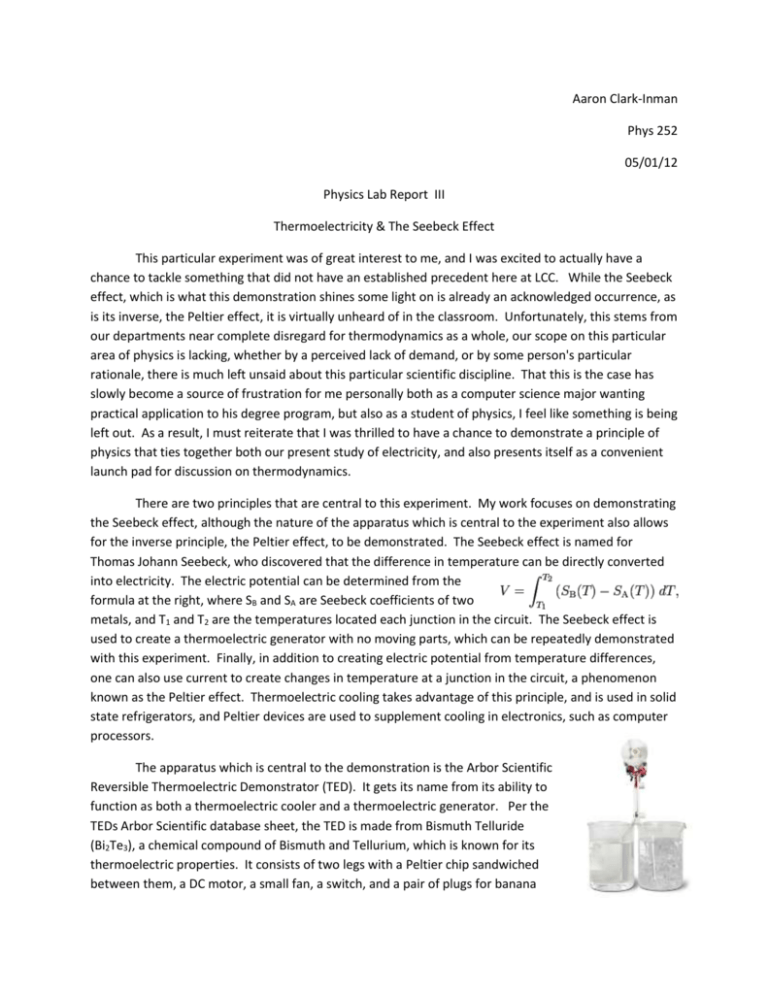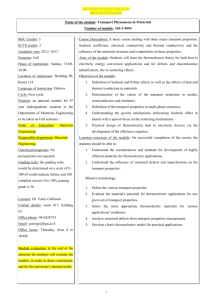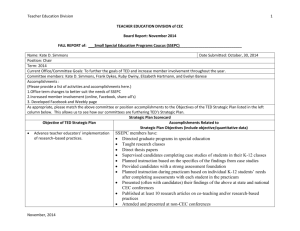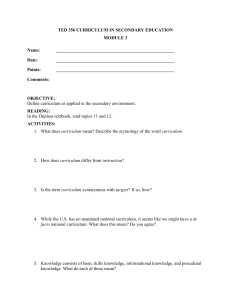Aaron Clark-Inman Phys 252 05/01/12 Physics Lab Report III
advertisement

Aaron Clark-Inman Phys 252 05/01/12 Physics Lab Report III Thermoelectricity & The Seebeck Effect This particular experiment was of great interest to me, and I was excited to actually have a chance to tackle something that did not have an established precedent here at LCC. While the Seebeck effect, which is what this demonstration shines some light on is already an acknowledged occurrence, as is its inverse, the Peltier effect, it is virtually unheard of in the classroom. Unfortunately, this stems from our departments near complete disregard for thermodynamics as a whole, our scope on this particular area of physics is lacking, whether by a perceived lack of demand, or by some person's particular rationale, there is much left unsaid about this particular scientific discipline. That this is the case has slowly become a source of frustration for me personally both as a computer science major wanting practical application to his degree program, but also as a student of physics, I feel like something is being left out. As a result, I must reiterate that I was thrilled to have a chance to demonstrate a principle of physics that ties together both our present study of electricity, and also presents itself as a convenient launch pad for discussion on thermodynamics. There are two principles that are central to this experiment. My work focuses on demonstrating the Seebeck effect, although the nature of the apparatus which is central to the experiment also allows for the inverse principle, the Peltier effect, to be demonstrated. The Seebeck effect is named for Thomas Johann Seebeck, who discovered that the difference in temperature can be directly converted into electricity. The electric potential can be determined from the formula at the right, where SB and SA are Seebeck coefficients of two metals, and T1 and T2 are the temperatures located each junction in the circuit. The Seebeck effect is used to create a thermoelectric generator with no moving parts, which can be repeatedly demonstrated with this experiment. Finally, in addition to creating electric potential from temperature differences, one can also use current to create changes in temperature at a junction in the circuit, a phenomenon known as the Peltier effect. Thermoelectric cooling takes advantage of this principle, and is used in solid state refrigerators, and Peltier devices are used to supplement cooling in electronics, such as computer processors. The apparatus which is central to the demonstration is the Arbor Scientific Reversible Thermoelectric Demonstrator (TED). It gets its name from its ability to function as both a thermoelectric cooler and a thermoelectric generator. Per the TEDs Arbor Scientific database sheet, the TED is made from Bismuth Telluride (Bi2Te3), a chemical compound of Bismuth and Tellurium, which is known for its thermoelectric properties. It consists of two legs with a Peltier chip sandwiched between them, a DC motor, a small fan, a switch, and a pair of plugs for banana jacks. Depending on the configuration of the device, it can switch between thermoelectric cooling and thermoelectric generation, hence the ‘reversible’ portion of its name. For the Peltier effect, a six volt lamp battery would be connected via banana to gator jacks, and each leg of the TED would sit in a beaker of water of equivalent temperature. When power is supplied to the TED, one leg will generate heat, while the other cools down. This will lead to measurable changes in the water temperature. As stated before, the reverse is also true. When one beaker contains hot water, the other cold water, and the battery is removed from play, if a great enough temperature differential should exist, the TED will generate electric potential. It is on this principal this particular demonstration is based. In this particular demonstration, the TED is positioned in two beakers, one hot, and one cold. My final two runs featured temperatures around 84 degrees Celsius to 4 degrees Celsius. Connected across the DC motor, at the switch and at the red jack, is a Vernier voltage differential probe. This is connected to a Labpro, which is in turn connected to a Lenovo Thinkpad R61. Each beaker of water contains a Vernier surface probe, both connected to the Labpro, and the final available spot on the Labpro is occupied by a Vernier thermistor, which is attached to the surface of the cold leg of the TED. The hot water is prepared by heating in a glass beaker on a Cimarec hotplate, and the cold water is water with ice thrown in. The two Vernier surface probes feed back to the Logger pro software the change in temperature of the water, most particularly that of the hot water, once it is removed from its heat source. In the case of the cold water, the ice cubes provide enough cooling that over the duration of the experiment (several minutes) that it will only fluctuate by a few degrees. The hot water meanwhile, without a heat source, with gradually cool to room temperature. As the temperature differential shrinks, theorectically the output voltage will drop, and as a neat little gimmick, the fan mounted to the TED will spin. Finally, the thermistor measures the temperature of the cold on the surface of leg near the location of the Peltier chip. The first time I setup the TED, I used hot tap water, and cold tap water, and looked for the fan to spin. With this approach, I did not get anywhere. Perry offered that the TED might be broken, and said he would be open to buying a replacement one. However, at that time I recalled reading on the ineffectiveness of the Seebeck-Peltier Effect, and I decided to keep pursuing a successful demonstration with this particular TED. I took it home, and over the weekend, tried again. This time I used the microwave to further heat the hot water, threw ice cubes in the cold water, and, at the suggestion of my father, filled the beakers higher. This time, the motor received enough power to turn the fan. I used my Fluke meter to measure the voltage output and came up with roughly .340 volts, and watched as it slowly decreased with the cooling of the hot water. It was at this point that I realized not only the general inefficiency of this thermoelectric principle, but also observed a change in the temperature of the TED due to ambient room temperature, something I had not first considered. I would add the thermistor and the surface probes to better monitor the temperature of the system, and see just how much overall effect it would have on the setup. I took the TED back to campus, and in the Physics shop I incorporated all the temperature monitoring devices, as well as the differential voltage probe, so that everything was all running through the Labpro, instead of trying to track voltage changed independently of the LoggerPro data, despite the fact that I personally have more faith in the quality of a Fluke meter in contrast to something that came from Vernier. I borrowed a working Cimarec hotplate from Chemistry (I knew it worked, I had already repaired it earlier this year), and cranked up the heat to 100 degrees Celsius. Once it reached boiling, I poured the water in the TEDs square beaker, and with the ice water already on hand, I inserted each prong of the TED into a beaker and watched the LoggerPro read out on the computer screen. With approximately a 76.5 degree Celsius temperature differential, I achieved at max a .523 volt output. As the graph at the right shows, there is gradual build up in voltage, even while the hot water begins to cool. I attribute this to the legs of the TED changing in temperature, from their former ambient room temperature, to the temperature of the water each leg is placed in. Once the legs meet the temperature of the corresponding beaker of water, the voltage output peaks. While the cold water remains relatively the same throughout the demonstration period (900 seconds) the hot water, in red, drops off by just over 20 degrees Celsius. As a result, the voltage output dips right along with it, falling to .310 volts by the end of the time frame. The yellow line measures the temperature of the cold leg of the TED, just before it meets the Peltier chip. While it holds relatively constant, it is much warmer than the cold bath would indicate, and has a significant effect on the experiment overall. I performed a second run of the experiment under the same setup, having been able to make the process more efficient. I still have a few issues to address, and maybe I figure out ways around them. Besides refining the general experimental procedure, the second run was also done to see just how long a notable voltage output could be obtained. This has less to deal with Seebeck effect, and more to do with ambient cooling, but, I performed a second run, and unfortunately did not achieve a higher voltage output, but was able to successfully gauge how long it would go. At the time when the fan ‘died’, around 2025 seconds, the voltage output behaves somewhat erratically. Due to the timing, I would attribute this with the fan terminating. Interestingly enough, while the fan no longer works, there is still around .145 volts being generated. However, in a demonstration of the inefficiency of the Seebeck effect, there is still roughly a 38 degree Celsius temperature differential. That it requires such a large differential to power the fan would explain why just use hot and cold tap water did not power the device in my initial runs. When I finally shut the system down, it had been operating for nearly 2500 seconds, and was still generating a .124 volts. While my focus thus far has been on the Seebeck effect, I did take the time to demonstrate the Peltier effect because it is the cooling aspect of it which makes it so useful for electronic appliances. Solid state cooling involves no mechanical parts, and as an old information technology professor once told me, “eventually, moving parts don’t.” While highly inefficient, due to the naturally high temperature extremes of say, a CPU, a Peltier chip can be used as a cooling device. With this in mind, using the same set up, but with relatively even temperature water, and a 6 volt lamp battery powering the fan and Peltier chip, I was able to generate a moderate temperature differential. In just over 400 seconds, with roughly 4.5 volts actually being applied to the Peltier chip by the battery, the thermistor on the hot side of the TED increased by 5 degrees Celsius. The water baths temperature differential increased by half a degree. Ideally, another thermistor would be helpful here, so as to document the total temperature differential on the legs of the TED itself, which would likely wind up being a follow up experiment, if I were to continue this train of research with more time. I suppose the key question I would be asking myself in this particular instance is whether or not a change in voltage supplied is reflected by a change in temperature differential. Throughout the course of this documentation I have mentioned the inefficiencies of both the TED itself, and the Seebeck-Peltier effect in general. I have up to this point subtlely acknowledged a key fault with the TED, and how it would be demonstrated, which brings me to the application of the thermistor. The thermistor serves to demonstrate the thermoconductivity of the metal, and to point out a glaring inefficiency in this particular TED. Unfortunately, due to the limit on the number of ports in a Labpro, a second thermistor cannot be hooked up to the main Labpro. However, now that I have done this multiple times, and based on the experience with the motion senor array from the mechanics course, I know two Labpros can be used in tandem, and so I think a better ideal setup in the future would leave the voltage probe on its own Labpro, and in its place, run another thermistor on to the hot leg of the TED. In this case the total loss of temperature differential due to ambient temperatures on the TED can be demonstrated. My demonstration with the Seebeck effect in particular demonstrates nearly a 15 degree Celsius loss in temperature differential between the thermistor near the Peltier chip, and the temperature of the waterbath. Experimenting with the Seebeck-Peltier effect has been an interesting experiment for myself this semester. Unlike previous experiments, there is no predetermined outcome. While the TED itself is some preassembled Chinese toy, actually creating the experiment to make it work was not something I am accustomed to. In most cases, there exists a lab somewhere in a book on how to demonstrate some given principle. In this case, I fashioned everything on my own, as this was something Perry acquired randomly, and to my knowledge is not in any of our lab books. Having done this several times now, I have found additional things I would address, one that I shall mention in passing is that the square beakers with the TED are made of plastic and I am afraid to heat them directly. Pouring hot water from a glass beaker to a plastic beaker causes a loss of heat, and although I account for that, it still presents itself as an annoying inconvenience. That said, this whole experiment was probably the most fun I have had in any physics class I have taken here at LCC, partially due to the free form nature of the assignment, but also because I finally have a toy I can play with that actually has merit in the field of computer science. After all, heat is the number two killer of computers, trailing only operator malfunction… Seebeck Run One Seebeck Run Two Peltier Run One Arbor Scientific Reversible Thermoelectric Demonstrator (TED)





